“Don’t linger,” two Taiwanese warn us as we stand in front of a shinto shrine, fog enveloping the emaciated Taiwan white fir. Mountain ghosts are everywhere and one may lead you off a cliff — a prophecy that seemingly came true three hours earlier when a woman plunged to her death, the victim’s blood staining the jacket of a rescuer we meet just before coming here to the West Peak (玉山西峰): On Jade Mountain (玉山), death is everywhere.
The reality, of course, is far more prosaic. Richard Saunders, a former Taipei Times travel columnist, had told me in June that a group hike up Jade Mountain is something that any outdoorsy person visiting Taiwan has to do at least once, especially the main peak where you can take a picture of yourself with the marker and receive a certificate of achievement (NT$300). The cost: NT$8,500, which includes the permit (mandatory for this part of Jade Mountain), transportation to and from the mountain, two nights accommodation, food and the guide. Having lived in Taiwan for almost two decades, I thought my Jade Mountain experience was long overdue.
Traveling with a group of strangers can be a crap shoot: you can get like-minded people who share interesting stories, or you could be stuck with a group who won’t keep quiet about opinions they think everyone needs to hear. For the most part, our group fell into the former.
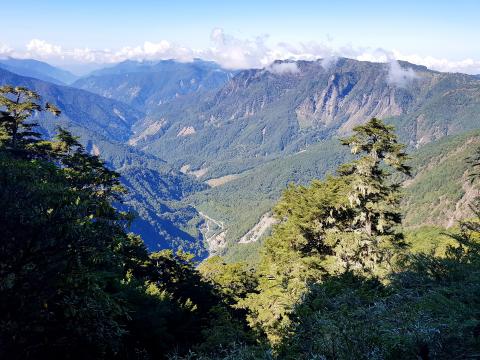
Photo: Noah Buchan, Taipei Times
The nine of us — our guide, a father and his 11-year old daughter, a South African couple, an Italian woman, a Taiwanese woman and one of my colleagues — meet at the Chiayi train station and drive up the mountain for two hours until we reach Dongpu Lodge (東埔山莊, 2,500 meters), where we will spend the night. When we arrive, most of the other climbers have gone to bed in expectation of waking up at 2am to get an early start on the mountain. Our group will leave at around 8am, climb at a leisurely pace and sleep at Paiyun Lodge (排雲山莊) so we can wake up early the following morning to catch the sunrise on the summit, or main peak (玉山主峰).
As we enter, our guide shushes our excited voices because two of the three rooms, each accommodating 20 sleepers on bunk beds, are already occupied with slumbering climbers. We examine the facilities, which are spartan: squat toilets, makeshift tables, stools. Electrical outlets are in short supply and there is a pile of mobile phones on a table waiting to be recharged. After a few hour’s banter, we move into the sleeping rooms.
Three hours later, I’m still awake. The climbers facing us begin to stir, rise from their slumber and pack up. One person packs and repacks their gear, headlights dancing off the walls, the rustling of plastic mixed with murmuring: they seem to have lost something and are clearly agitated, a reflection of my own growing annoyance. What is the etiquette here? Can I tell the person to shut the hell up, turn off the light and pack outside, like our guide rightly told us to do? Or should I just hold my counsel in the knowledge that I can’t sleep and, anyway, they’ll probably be gone soon enough.
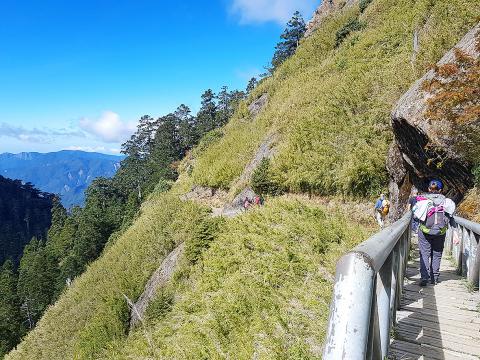
Photo: Noah Buchan, Taipei Times
Another of their party comes into the sleeping quarters and starts asking what his partner is looking for; at that point I and another of our group tell them people are trying to sleep. We do this a second time before they leave. The person next to me soon falls asleep; I don’t get a wink.
The morning is a whirlwind of coffee, muffins and packing: we depart Dongpu Lodge at 8am and head to the Tataka police office, a 10-minute walk up a road, to show them our permit. While there, the police officer tells me that they give out 120 to 130 permits per day and usually weekends are busiest so it’s advisable to book months in advance. A shuttle bus arrives to transport (NT$100 each way) our party to the trailhead.
PAVILION AND OBSERVATION DECK
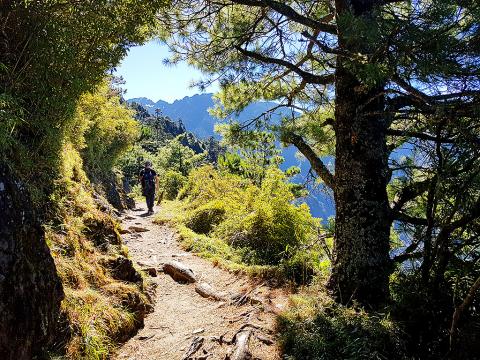
Photo: Noah Buchan, Taipei Times
The popularity of Jade Mountain ensures that its paths are well maintained and clearly marked. A sign about altitude sickness greets us at the trailhead (2,610 meters). The same sign shows the different points to stop and rest, including the Monroe Pavilion (2,792 meters) and the White Forest Observation Deck (3,042 meters).
The trail up is about a meter wide and a mixture of broken rock, stamped earth and wooden bridges, sided by trimmed bamboo, and a mixture of Chinese hemlock, cedar and Taiwanese fir. At this point, there are only a few clouds in the sky, with open vistas of the distant peaks and dry river beds below. Our party breaks up into smaller groups according to our climbing ability and I’m eventually alone walking at a leisurely pace, rarely encountering other climbers, until a few hours pass and I reach the Monroe Pavilion, a small structure shrouded in bush, the views obscured by dense jungle. As I’m ahead of most of the party, I sit down, take out a health bar, fruit, water and my notebook and send off some photos — yes, mobile reception is available here, and will work, most of the way up the mountain. The temperature has become cooler.
Soon we arrive at the White Forest Observation Deck and we see the rescue helicopter and learn of the death. A park ranger later tells us that there is usually one accident a month on the mountain.
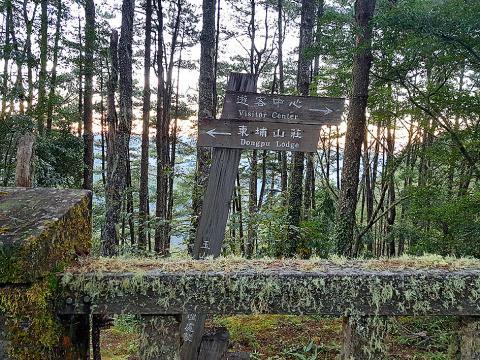
Photo: Noah Buchan, Taipei Times
The path from the trailhead to the observation deck has been challenging, but not overly so. The final 1.5km (400 meters of elevation) to the lodge, however, is far steeper in parts. This final bit of trail finds me stopping roughly every 10 meters — to take photos and drink water. My wrist watch shows that my heart is beating 203 beats per minute. When I arrive at Paiyun Lodge at around 1pm, my legs are sore, and I take a seat with the dozen or so other climbers on the large wooden deck that overlooks the valley below.
THE WEST PEAK
When our guide reaches the lodge, he tells us that we have a choice: rest or travel on to the West Peak (3,518 meters). Myself and four others opt for the latter, an added jaunt that will take three hours there and back.
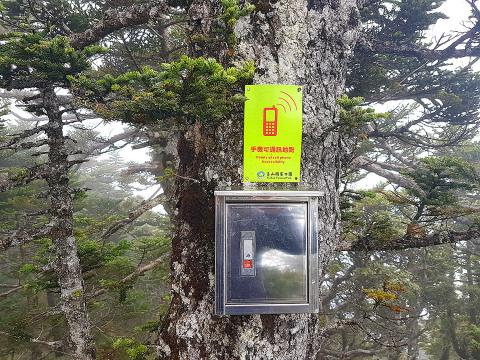
Photo: Noah Buchan, Taipei Times
The topography and flora along the path have changed from deciduous forest to jagged rock punctuated here and there with coniferous trees. The sun has disappeared amid the rise and falling fog.
Although our vision is limited by the increasingly dense fog, this is a very enjoyable hike, with fewer steep sections — it is, after all, only 100 meters or so higher than the lodge — and more areas where the path is visible for a long distance. When we reach the peak two us move on to the shinto shrine, located about 100 meters beyond.
A sign beside the shrine tells us that it is a replica of the kind the Japanese erected when they occupied Taiwan and built roads up several mountains to access virgin forest. The shrine houses Amaterasu, the sun goddess. The information board doesn’t explain what scared away the two Taiwanese men.
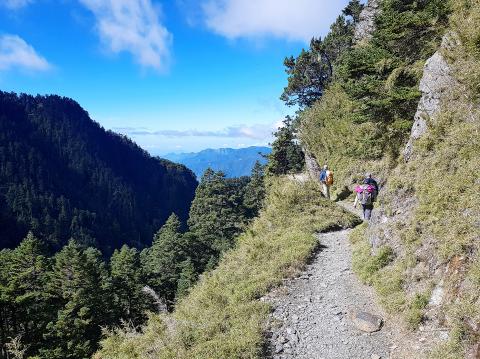
Photo: Noah Buchan, Taipei Times
By the time we return to Paiyun Lodge, there are roughly 100 people inside and outside and in the many rooms for sleeping that, like Dongpu below us, holds up to 20 in bunk beds. The lodge up here is much cleaner and more spacious than Dongpu. Most hikers agree that the cold tap water is drinkable because it is sourced from the mountain. I fill up my bottle.
THE SUMMIT
At 5:30pm our group is called for dinner: chicken or pork with rice and vegetables. Meals, like everything else at Paiyun, are simple because people have to trek it up the mountain by foot everyday.
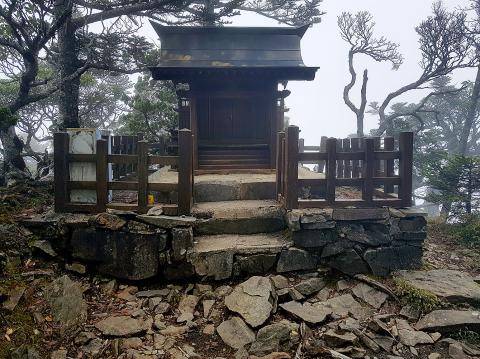
Photo: Noah Buchan, Taipei Times
An hour later, and I’m under the sheets, telling myself that within the next eight hours I will almost certainly be able to catch a few hours before waking up at 3am to climb the summit. It doesn’t happen. As the minutes pass to hours, I realize that I won’t catch a moment’s sleep. I put on my noise-canceling headphones, but those don’t work because I can’t lay on my side while wearing them. It only dawns on me later that I should have tried to sleep outside (an option, though camping is not allowed near the lodge).
And so it goes. Three o’clock arrives, and I still haven’t slept. Without sleep, I’m feeling dizzy and somewhat confused, an awareness that becomes more pronounced as I leave our room and walk down to the deck overlooking the valley, the stars in the sky competing for enchantment. Most of our group has already set out, their headlights and dozens of others forming an illuminated snake up the mountain. I think that I’ve come all this way, but also think of the rescue helicopter and the four hour descent waiting for me when I return from the summit, in addition to the knowledge that this is the most difficult part of the climb. I stifle my pride and decide to skip the summit and stay behind and try to sleep at the now-deserted lodge. It works. For the first time in 48 hours I am able to sleep, only waking when the other climbers return starting at 7:30am.
For details of climbing Jade Mountain, including booking a room at Paiyun Lodge and applying for permits, visit: npm.cpami.gov.tw. For complete details about Yushan (Jade Mountain) National Park, including entry permits, routes and weather conditions, visit: www.ysnp.gov.tw.
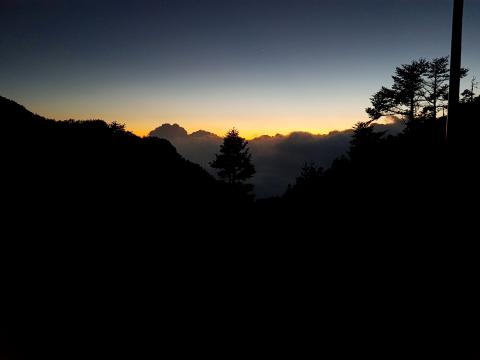
Photo: Noah Buchan, Taipei Times

The unexpected collapse of the recall campaigns is being viewed through many lenses, most of them skewed and self-absorbed. The international media unsurprisingly focuses on what they perceive as the message that Taiwanese voters were sending in the failure of the mass recall, especially to China, the US and to friendly Western nations. This made some sense prior to early last month. One of the main arguments used by recall campaigners for recalling Chinese Nationalist Party (KMT) lawmakers was that they were too pro-China, and by extension not to be trusted with defending the nation. Also by extension, that argument could be

Aug. 4 to Aug. 10 When Coca-Cola finally pushed its way into Taiwan’s market in 1968, it allegedly vowed to wipe out its major domestic rival Hey Song within five years. But Hey Song, which began as a manual operation in a family cow shed in 1925, had proven its resilience, surviving numerous setbacks — including the loss of autonomy and nearly all its assets due to the Japanese colonial government’s wartime economic policy. By the 1960s, Hey Song had risen to the top of Taiwan’s beverage industry. This success was driven not only by president Chang Wen-chi’s

Last week, on the heels of the recall election that turned out so badly for Taiwan, came the news that US President Donald Trump had blocked the transit of President William Lai (賴清德) through the US on his way to Latin America. A few days later the international media reported that in June a scheduled visit by Minister of National Defense Wellington Koo (顧立雄) for high level meetings was canceled by the US after China’s President Xi Jinping (習近平) asked Trump to curb US engagement with Taiwan during a June phone call. The cancellation of Lai’s transit was a gaudy
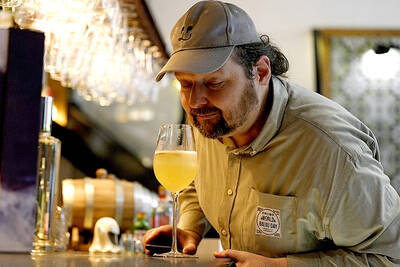
The centuries-old fiery Chinese spirit baijiu (白酒), long associated with business dinners, is being reshaped to appeal to younger generations as its makers adapt to changing times. Mostly distilled from sorghum, the clear but pungent liquor contains as much as 60 percent alcohol. It’s the usual choice for toasts of gan bei (乾杯), the Chinese expression for bottoms up, and raucous drinking games. “If you like to drink spirits and you’ve never had baijiu, it’s kind of like eating noodles but you’ve never had spaghetti,” said Jim Boyce, a Canadian writer and wine expert who founded World Baijiu Day a decade